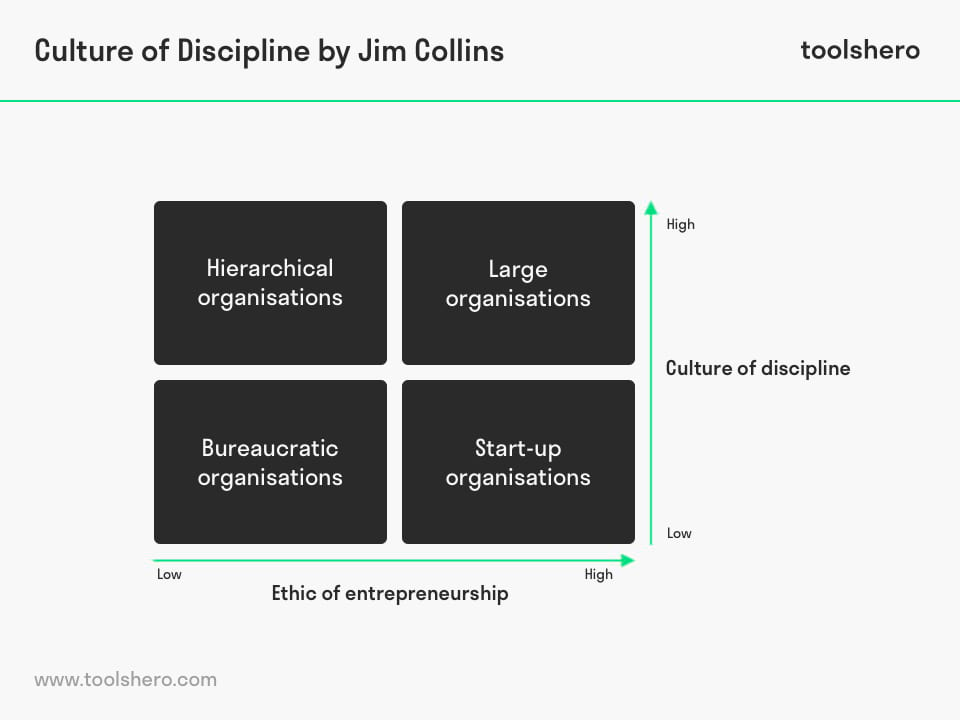Culture of Discipline by Jim Collins explained

Culture of Discipline: this article describes the Culture of Discipline, developed by Jim Collins in a practical way. Next to what it is, this article also highlights the three Focus Areas and the Discipline and Entrepreneurship. After reading you will understand the definition and basics of this management and organizational development tool. Enjoy reading!
What is the Culture of Discipline?
In 2001, American management consultant Jim Collins wrote about the Culture of Discipline in his book ‘Good to Great‘. In the book, he describes how disciplined people are capable of great achievements.
They have the gift of disciplined thinking and undertaking actions that lead to a well-defined final goal. Jim Collins indicates that the ‘discipline culture’ can be combined with the ‘ethic of entrepreneurship’, each valued from high to low.
As a result, four combinations can be created that represent a certain type of organisation with their own unique combination.
Culture of Discipline: growing organisation
According to Jim Collins, it’s important to cultivate a ‘Good to Great’ discipline culture to allow an organisation to grow.
This all starts with a team of disciplined people. It’s not about teaching the wrong people about disciplined behaviour, but about gathering and putting together self-disciplined people. Only then can an organisation profit and grow. Their way of thinking is different and they hold on to the goals they set with complete and total determination.
For many entrepreneurs, discipline is a natural certainty. They work hard and are determined to reach their goals, which usually leads to success. When growing to a larger and more professional organisation, entrepreneurs can no longer trust in their own discipline; they become dependent upon the people they hire.
Perhaps they expect a certain level of discipline from these employees. The only thing they can contribute to this process is setting the right example. It is precisely disciplined leaders who are capable of creating a culture of discipline within an organisation.
Culture of Discipline: 3 Focus Areas
A culture of discipline certainly doesn’t have to be equated with a dictatorship.
Discipline isn’t about forcing others to display certain behaviour or adhere to specific rules. Rather, it’s about creating systems and processes employees and teams must follow and that motivate them to do so.
Jim Collins defines 3 focus areas of discipline:
1. Disciplined people
First, it is essential to compose a good team. This is only possible by adjusting the hiring policy accordingly, allowing the organisation to look for new, disciplined professionals who take responsibility and are fully motivated in fulfilling their tasks.
The entire management structure must radiate this discipline; it must become part of the organisational culture. In case of a lack of discipline on a management level, the predefined SMART goals will never be reached.
2. Disciplined thought
According to Jim Collins, organisational growth can only be achieved through disciplined thought. This means an organisation should focus on what they’re good at.
This forms the basis of his earlier Hedgehog concept, in which he uses the example of a Greek parable about a fox and a hedgehog. The fox is clever and knows a lot, while the hedgehog is really only good at one thing; rolling up into a ball in case of danger.
According to Collins, companies can greatly benefit from focusing on their own speciality – just like the hedgehog. By taking a disciplined approach, an organisation is able to realise further growth. If companies more often consider what they’re best at compared to their competitors, this will yield an advantage in the long term.
3. Disciplined actions
After organisations have established their primary business focus, a strategic plan can be defined. Actions must be taken to carry out this Action plan.
This also demands discipline. And this is often where things go away. The strategy is clear, but it’s unclear how the goal can be reached. Collins indicates that to-do lists encourage completing actions, but that it’s also beneficial to work with ‘stop goal lists’.
After all, some goals may no longer be relevant in achieving the strategic final goal. Anything that doesn’t fit within the organisation’s growth plan, should be crossed off.
By defining specific goals, regularly reporting on the results and capturing these in statistics, it becomes clear what the organisation has achieved and whether the right course is being sailed.
Culture of discipline is Discipline and Entrepreneurship
According to Collins, it’s important to place two complementary forces opposite each other; ‘Culture of discipline’ on the one hand and the ‘ethics of entrepreneurship’ on the other.
This combination gives rise to a magical collaboration that leads to superior achievements with lasting results. Here, the culture of discipline is about the responsibility people have towards themselves, their team and the organisation.
The ethic of entrepreneurship concerns the degree of independent entrepreneurship, the ambitions to grow and the possibilities and opportunities that are avidly seized. From these two factors, the following four organisational types arise:

Figure 1 – Culture of discipline matrix
Start-up organisations – low culture of discipline / high ethic of entrepreneurship
New start-ups are fed by creativity, opportunities, gumption and visionary goals. There is a great drive for independent entrepreneurship. On the other hand, discipline is very low.
Specific procedures hardly exist and anything’s possible. There is a lack of systems, planning and accountability. Over time, the organisation will mature and require more structure.
Large organisations – high culture of discipline / high ethic of entrepreneurship
Here, Collins refers to multinationals where it’s important that work is performed in accordance with procedures and established agreements. There is a high degree of discipline in both the work structure and the organisational culture; each employee and team knows exactly what is expected of them and what their final goal is.
A large organisation is often a cumbersome entity. As a result, divisions often arise, each with their own ethic of entrepreneurship, that work on new ideas full of enthusiasm and that view new opportunities as a challenge.
Hierarchical organisations – high culture of discipline / low ethic of entrepreneurship
Hierarchical organisations certainly possess a high degree of discipline. Everything goes according to established procedures and methods and deviating from these is immediately punished.
The end result is what counts and the managers command respect. They check the activities and want everyone to work in a disciplined way.
On the other hand, these organisations are characterised by a very low ethic of entrepreneurship.
There is hardly any creativity and innovation. But this type of organisation doesn’t need it.
Bureaucratic organisation – low culture of discipline / low ethic of entrepreneurship
The goal of bureaucracy is to prevent mistakes as much as possible.
A municipal organisation, for instance, can’t determine what the issued passport or driving license looks like; strict rules and legislation that mustn’t be deviated from apply here.
Therefore, each employee knows exactly what procedures he must follow. As soon as a task has been completed, the employee can lean back and hardly takes responsibility for the work he performs. Here too, there is a lack of ethic of entrepreneurship; there is no interest in new challenges and each change is viewed as an obstacle.
It’s Your Turn
What do you think? What is your experience with the Culture of Discipline? Do you recognize the practical explanation or do you have more additions? What are your success factors for creating a disciplined team to allow an organisation to grow?
Share your experience and knowledge in the comments box below.
More information
- Boehm, B., & Turner, R. (2004, May). Balancing agility and discipline: Evaluating and integrating agile and plan-driven methods. In Proceedings. 26th International Conference on Software Engineering (pp. 718-719). IEEE.
- Collins, J. (2006). Level 5 leadership: The triumph of humility and fierce resolve. Managing Innovation and Change, 234.
- Collins, J. (2009). Good to Great-(Why Some Companies Make the Leap and others Don’t). HarperBusiness.
How to cite this article:
Mulder, P. (2019). Culture of Discipline. Retrieved [insert date] from Toolshero: https://www.toolshero.com/management/culture-of-discipline/
Original publication date: 02/19/2019 | Last update: 06/20/2023
Add a link to this page on your website:
<a href=”https://www.toolshero.com/management/culture-of-discipline/”>Toolshero: Culture of Discipline</a>












